As this is an older post of mine that gets many visits I would like to add some notes today. People often ask me “How can I help?”.
Abu Zaabal is always happy to welcome volunteers of all sorts, medical professionals, social workers or simply people who could share some of their time to help patients or to renovate or repair facilities. Donations are also needed. Some of the medical equipment is really old like for example the x-ray machines and new ones are urgently needed. People who would like to help can visit Abu Zaabal, talk to the nuns there and find out which help would be useful right now. Contacting Caritas Egypt can also be an option.
On another note I’m looking for a possibility to exhibit these photos in order to raise more awareness. If some health NGO, cultural or art place or some company out there is interested in this kind of exhibition, PLEASE contact me.
HERE the story starts: Although leprosy is on the verge of extinction and many people totally forgot about this disease, there are still some leprosaria or leprosy colonies as they are often called. This is not a story about suffering and misery, but rather about a strange micro-cosmos, a place unknown to most people: the leprosy colony Abu Zaabal in Qalyoubiya, 40km north of Cairo. All tourists that fly into Cairo could see it from above as it is quite close to the airport if they would know that it is there. About 750 patients are still living there, and another 3,000-4,000 cured lepers are living in the adjoining Abdel Moneim Riad village.

© Claudia Wiens
The bacterium responsible for leprosy was discovered in 1873 by the Norwegian Dr Armauer Hansen, and a whole section in Cairo’s Agricultural Museum was dedicated to bacterial diseases like leprosy and tuberculosis. The display in the museum remains as if nothing had changed since.
© Claudia Wiens
Until the 1930s, the illness was seen as uncurable and highly infectious. Left untreated, leprosy can be progressive, causing permanent damage to the skin, nerves, limbs and eyes. In fact leprosy is not highly infectious, as approximately 95% of people are immune and sufferers are no longer infectious after only a couple of days treatment.
© Claudia Wiens
Abu Zaabal was built in 1933 encompassing a hospital…
© Claudia Wiens
…and agricultural land in order to be self-sustainable.
© Claudia Wiens
Lepers were brought in by police and were not allowed to leave for isolation was seen as the only treatment. It was a big open air prison. Circumstances back then were horrible with mice chewing away on lepers’ wounds while sleeping.
© Claudia Wiens
During the past decade Abu Zaabal received a total make-over and became a friendly, peaceful place with all of the necessary facilities.
© Claudia Wiens
When Dr Karam Shakshak and Dr Ahmed Al Thokaby, the recent director, arrived at the beginning of this decade they first renewed the water station as the whole place had no clean water at all. Now there is a waste water treatment plant on the grounds of the colony and provides the hospital with clean water.
© Claudia Wiens
Ibrahim, a cured patient operates the barber shop.
© Claudia Wiens
A little mosque is frequented a lot by everybody who can walk. A priest visits Christian patients regularly.
© Claudia Wiens
Prayer time in the mosque.
© Claudia Wiens
The colony has its own bakery.
© Claudia Wiens
What would be a micro cosmos without a coffeeshop? Radi, another ex-patient is managing the coffeeshop.
© Claudia Wiens
Nadia, his wife, a fragile and very sick woman, often gives him company.
© Claudia Wiens
Men playing domino outside the coffeeshop.
© Claudia Wiens
Three Comboni Sisters and two Elisabetine Sisters, two Italian orders, come every morning from Cairo-Heliopolis to Abu Zaabal to help the leprosy patients. Sister Vittoria (left) lives for 45 years in Egypt and works for 26 years in Abu Zaabal.
© Claudia Wiens
Abu Zaabal has a big section for men and a smaller for women because generally less women get infected by leprosy. There are bigger and smaller sleeping wards, where every patient has his/her own bed and cupboard. Most rooms have a TV as well.
© Claudia Wiens
Patients who lost their legs or parts of it get well fitting protheses and learn to live with them. Often it was impossible for me to differentiate.
© Claudia Wiens
All wards have their own kitchens where men or women cook together like in a flat share. But for those who are too weak and sick there is a big kitchen where healthy food is prepared for them.
© Claudia Wiens
Abdullah, also a cured leper, helps to distribute the food to the patients.
© Claudia Wiens
Abdullah also helps with cleaning.
© Claudia Wiens
Most mornings patients with open wounds come to the clinic to get their bandages changed.
© Claudia Wiens
In the old days patients received one bandage per month and had to wash it with unclean water every few days.
© Claudia Wiens
In the early mornings Ibrahim, also an ex-patient, helps changing bandages.
© Claudia Wiens
I was worried about taking photos while patients have their bandages changed. But unexpectedly I found a relaxed atmosphere. The guys were chatting with each other and even joking. It is part of their daily routine and they exchange news while a nurse cleans out their wounds.
© Claudia Wiens
As the nerves are often destroyed patients do not feel the pain, which can be very dangerous as they often do not notice infections or injuries.
© Claudia Wiens
The operation rooms got better equipment, especially for ear, nose and throat operations. And most importantly the hospital got a back-up generator after power cuts occurred during surgery causing a disaster.
© Claudia Wiens
In fact the hospital here is now better equipped and kept cleaner than many governmental hospitals in Egypt.
© Claudia Wiens
After helping in the clinic Ibrahim continues working in his little workshop where he fabricates special shoes for those who have deformations on their feet.
© Claudia Wiens
Six years ago Jehad, aka Manuela, a German woman who lives in Egypt for more than 20 years, turned the uncared of and full of rubbish grounds of Abu Zaabal into a paradise like garden.
© Claudia Wiens
A team of 13-15 men, all cured patients, are helping to keep the garden clean and beautiful. They receive a small salary for their work. Most ex-lepers, especially if they have deformations can’t find jobs anymore.
© Claudia Wiens
Ahmed Mohamed (49) is one of them. The disease started when he was 18, but like many others the doctor discovered very late that he was suffering from leprosy. In 1980 he came to Abu Zaabal and received Multi Drug Treatment (MDT) and was finally cured. He met his wife here, also a common story, and they have five healthy children.
© Claudia Wiens
Jehad does not only take care of the garden she also visits those patients who suffered so much from leprosy that they have to spend their lives in bed. Sheikh Sayed, 88, suffered from leprosy since he was six years old. But only when he had an eye operation at the age of 18 the doctor diagnosed him with leprosy.
© Claudia Wiens
For 63 years he lives now in Abu Zaabal, blind, with disfigured mouth and nose and limps. But he listens to the radio every day and is up to date with world news.
© Claudia Wiens
Despite his tough destiny he still likes to joke. “Hagiblik gateau?” “Can I get you some cake?” he said and giggled about his own joke when I was talking to him.
© Claudia Wiens
Gohari ,18, is the youngest male patient at Abu Zaabal. He finished his MDT treatment and now receives physiotherapy for his hands. Effective treatment for leprosy appeared in the late 1930s with the introduction of dapsone and its derivatives. However, leprosy bacilli resistant to dapsone gradually evolved and became widespread, and it was not until the introduction of Multi Drug therapy (MDT) in the early 1980s that the disease could be diagnosed and treated successfully.Belonging to the younger generation Gohari dose not want to spend his life in the colony but wishes to go return to Kafr El Sheikh, his home town, and continue school.
© Claudia Wiens
The older patients, who live 30, 40 years or even longer in the colony don’t want to return to their often rural villages.
© Claudia Wiens
In the past they were often stigmatized and had to live the lives of pariah. So they got married in Abu Zaabal, moved to the neighbouring village and made their homes here. Also nowadays the living conditions in Abu Zaabal itself are much better than in a rural poor Egyptian village where most patients come from.
© Claudia Wiens
He is visiting his grandmother and shows off some of his religious tattoos.
© Claudia Wiens
Many patients have old fashioned cookers and brew their own tea.
© Claudia Wiens
© Claudia Wiens
Cooking together comes often with little arguments about taste and ingredients. It reminded me very much of some of my own flat share experiences and arguments about who should cut the damn onions.
© Claudia Wiens
His father had just his second leg amputated. He was another case where leprosy was way too late in being diagnosed.
© Claudia Wiens
The about 55 nurses sometimes have exhausting days. Although many of those I talked said that they enjoy their work at Abu Zaabal. But payment is so low that some of them work at another hospital in the evenings.
© Claudia Wiens
About 120 women patients are living at Abu Zaabal, and about another 130 come here for treatment.
© Claudia Wiens
Saneya (85) lives here for more than 50 years.
© Claudia Wiens
Although she has deformed feet and hands she manages to walk around and prepare her own food. I had many funny conversations with here and couldn’t believe how lucid she is. She loves to sing, tease other younger patients and has a wicked humor. She kept nagging me to bring along my boyfriend to check him out.
© Claudia Wiens
© Claudia Wiens
Makhita
© Claudia Wiens
Nasra is another long time patient.
© Claudia Wiens
This woman has no legs anymore and has to stay in bed all the time.
© Claudia Wiens
The women also have their communal kitchen where they can cook together while others opt to cook on a small stove beside their beds.
© Claudia Wiens
Cooking duties.
© Claudia Wiens
He and his wife come in daily to sell vegetables to the patients.
© Claudia Wiens
Jehad shares some love and tenderness with Nadia.
© Claudia Wiens
Warda (80) lives there for 35 years and loves to listen to soap operas and music on her radio.
© Claudia Wiens
Some patients have their own little rooms.
© Claudia Wiens
Sister Laura is the only Egyptian nun at the colony and works here for five years as a nurse.
© Claudia Wiens
Every morning she visits all women, gives injections,…
© Claudia Wiens
….cleans wounds,…
© Claudia Wiens
…does check ups…
© Claudia Wiens
….combs hair…
© Claudia Wiens
… and consoles, laughs and jokes with them.
© Claudia Wiens
Everybody who is strong enough does washing, cleaning, cooking and helps those who aren’t. Life here is like in a big community, but somehow totally detached from the outside world.
© Claudia Wiens
Her nickname is Batta.
© Claudia Wiens
Even though life here is often very hard, patients like to have some fun together.
© Claudia Wiens
Visitors help to make time pass.
© Claudia Wiens
Cat love.
© Claudia Wiens
As one of Abu Zaabal’s biggest donors Caritas Egypt founded in 1982 a socio-medical centre in adjoining Abdel Moneim Riad village. In their preschool/kindergarden they serve about 120 children of lepers and ex-lepers. The children learn reading and writing,…
© Claudia Wiens
….get one healthy meal including fresh milk.
© Claudia Wiens
And get to play in their new playground.
© Claudia Wiens
© Claudia Wiens
Dr Mona, the dermatologist of Abu Zaabal for more than 30 years comes three times a week to the Caritas Centre to treat children free of charge.
© Claudia Wiens
Parents often can’t afford to pay for a doctor.
© Claudia Wiens
Italian Sister Lina (88), as old as the oldest patients, is the coordinator of the Caritas Centre. It is more and more difficult to find young women who would serve as nuns for the leprosy colony or social work in general.
© Claudia Wiens
The center also provides women with courses in sewing. Some of the products are later on sold at the center.
© Claudia Wiens
The one kilometre between Abu Zaabal and Abdel Moneim Riad village people walk or take pick-ups and microbuses.
© Claudia Wiens
Nobody knows exact numbers but approximately 650 families, up to 4000 people, live in this village.
© Claudia Wiens
Zeinab from Upper Egypt, is an ex-patient of Abu Zaabal where she met her husband. They settled down here, had three healthy children. Now Zeinab sells vegetables in the street in front of her house. Here she doesn’t have to fear from stigma and horrible comments.
© Claudia Wiens
Fresh milk for four Egyptian Pounds per litre is unaffordable for many people.
© Claudia Wiens
Many of the villagers remain dependent on the colony because of their deformations and receive necessary medications and support from it.
© Claudia Wiens
© Claudia Wiens
Doaa, 30, cured, also met her husband in the hospital and they decided to settle here after her husband worked in a cheese factory but got fired when they found out that he had suffered from leprosy. Now they have built a little house and she opened a grocery shop and is very proud that she can contribute to their living. The ultimate goal for leprosy patients in Egypt is to live a normal life in their communities, receive treatment there and go on with their lives.
© Claudia Wiens
Living in Abu Zaabal should only be a temporary thing, ideally only for the time of treatment. Returning to their original homes will hopefully be the future.



















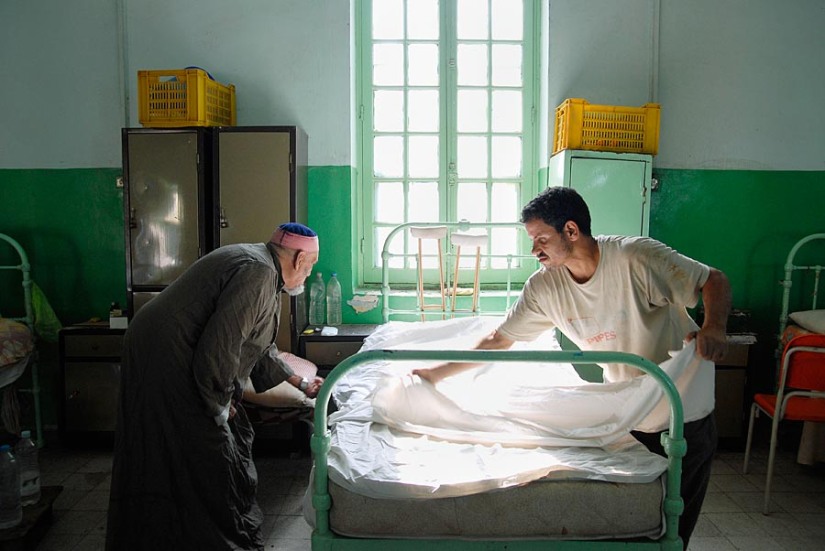


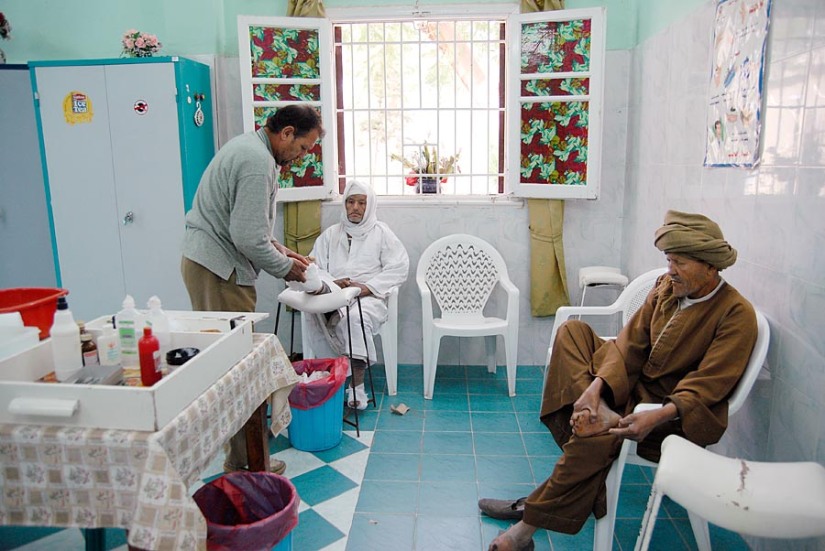









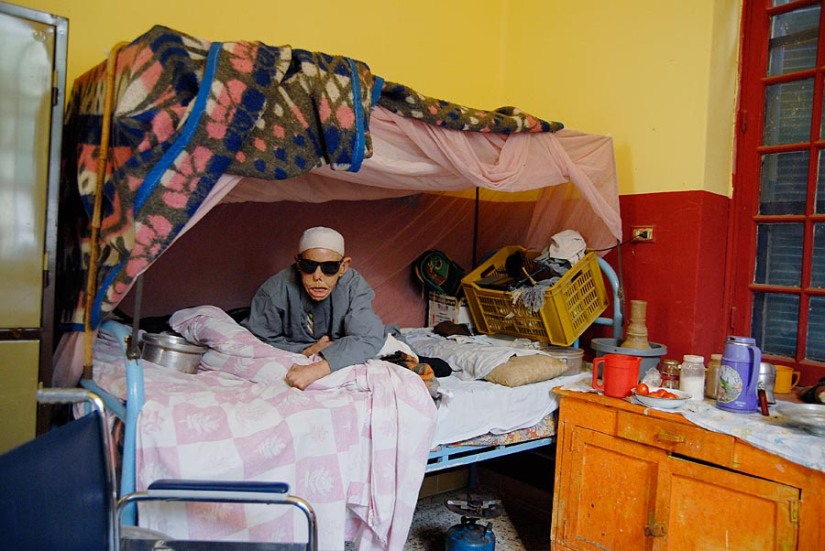



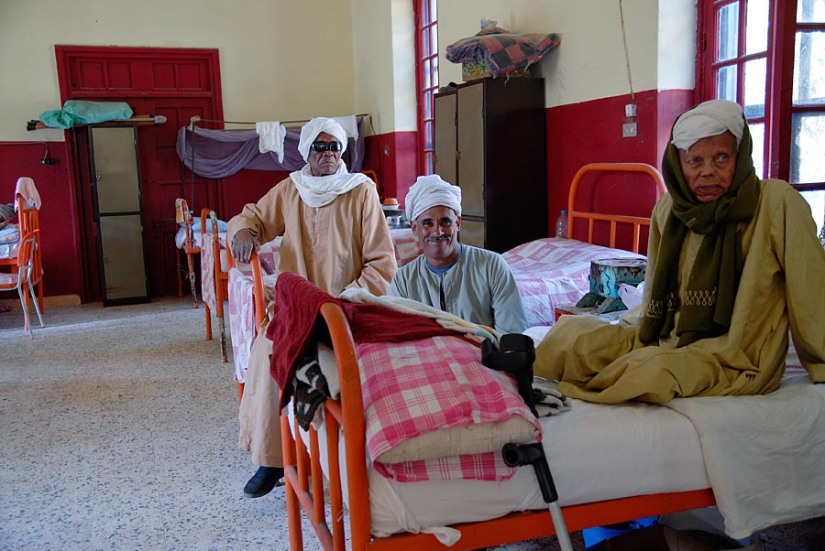





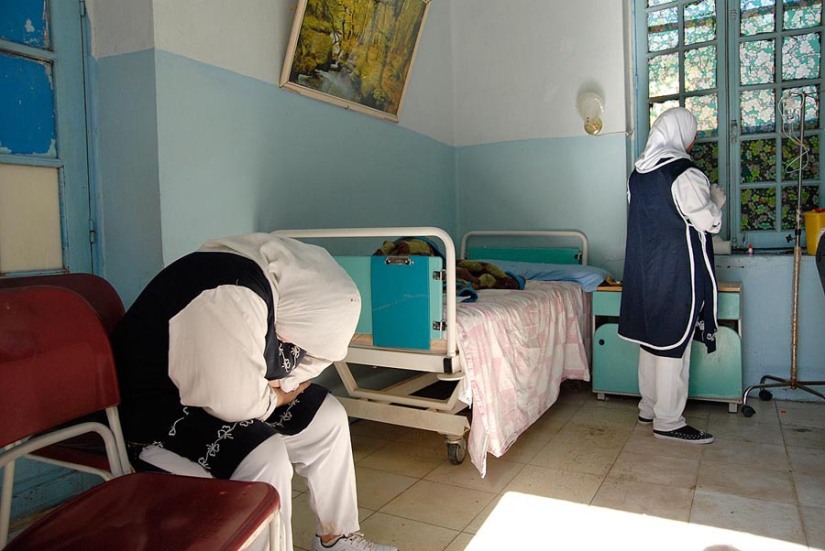



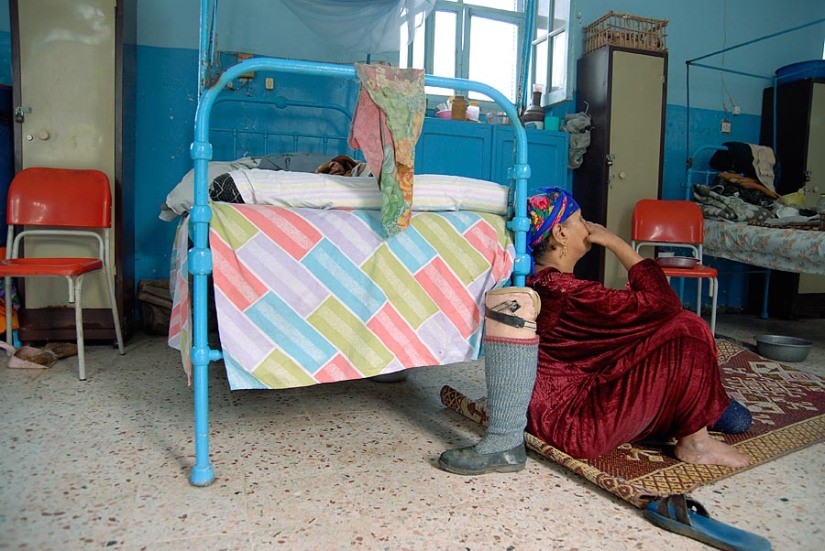






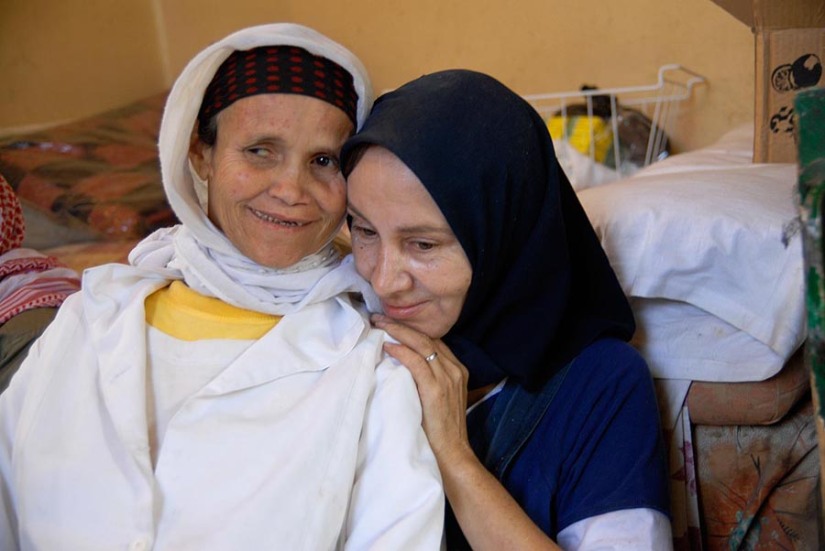






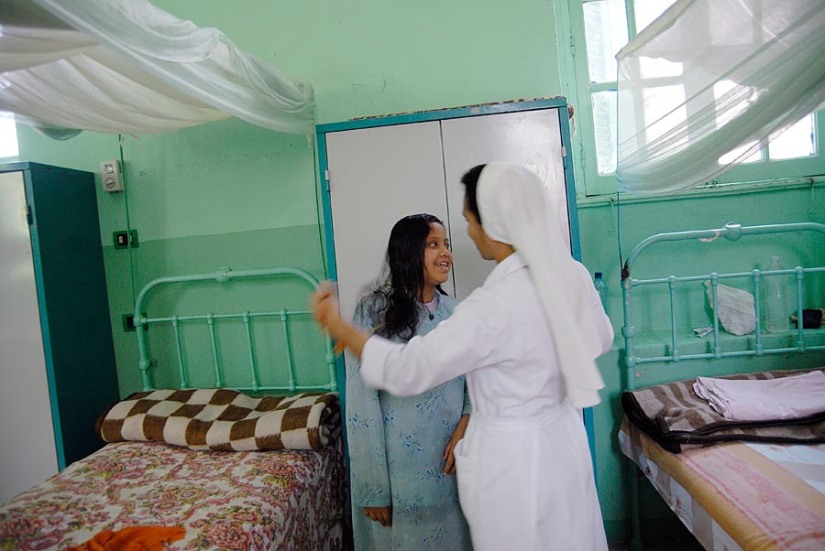









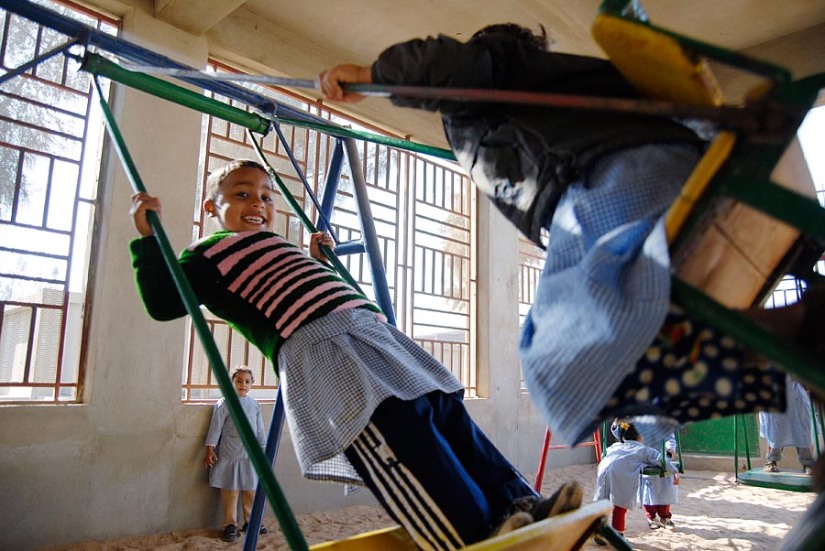

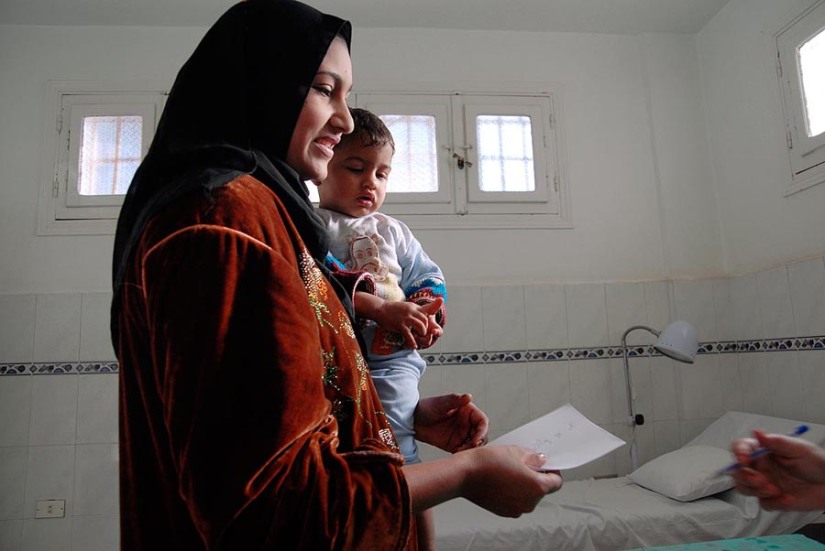


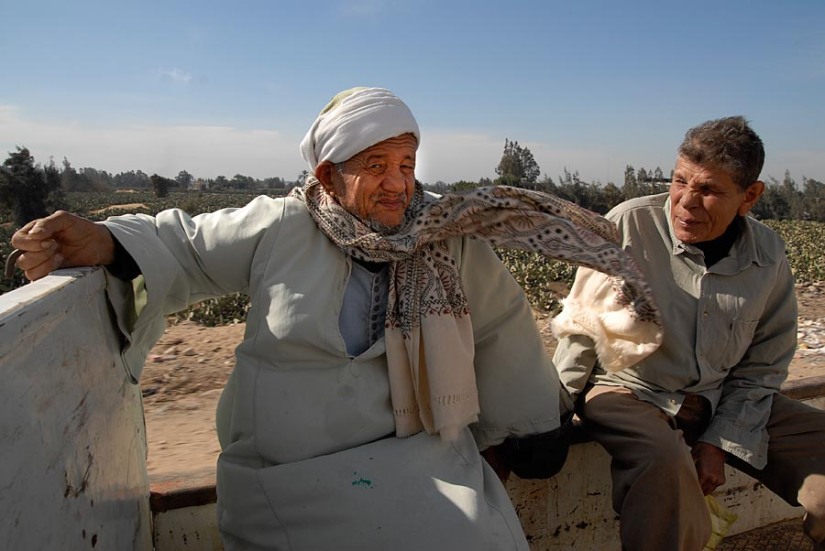







A very moving story, you did an excellent job at portraying them as real people living real lives. Excellent control of light and exposure – particularly some of the back lit shots. Excellent job.
Dear Claudia, I am deeply impressed by your curageous and respectful work! And a chance for the people to get somebody to tell THEIR Story to the world. To put the spot of enlightenment onto that reality means reducing the fear from Leprosy. And the knowledge hopefully brings more acceptance into the society; that they do not have to banish their people and give them space to take part of “normal” living.
All my respect to those, who take care to another!
PS: And hopefully the egyptian medicines are getting a better education for the future prophylaxis !!!
Some of your best work. I hope it goes beyond this to an exhibition or possible publication.
Hallo Claudia,
wau, nördlich von Kairo gibt es eine Leprakolonie, das wusste ich nicht. Deine Bilder erzeugen bei mir eine Gänsehaut.
Sie zeigen Deinen Respekt vor diesen Menschen und sollten unbedingt in einer Ausstellung in Deutschland gezeigt werden.
Liebe Grüße aus Dortmund
Rita
A nice moving story Claudia. Being from India I know how the society look down upon the patients, though massive campaigning drive from government and non-government agencies have helped to increase the general awareness.
However I think the story could gain from a tighter edit. Also I would insist you to prepare a slideshow with the text and some voice over; this is a pretty interesting story.
Thank you for sharing Claudia. Very interesting and important work. A lot of good photos. I also think it could benefit from a tighter edit. Looks like you put a lot of effort into it.
Congratulations!
Rachael
Hi Claudia,
This is a fantastic project, beautiful people and wonderful photographs. I especially like the gateau guy! I had never heard of this community before, and I hope your work finds a wide audience. Thanks!
Cassie
Fantastic photography. I wrote a feature story about the colony for Egypt Today (you can read it <a href=”http://etharelkatatney.blogspot.com/2008/07/last-of-lepers.html”here) and I wish you’d been my photographer 🙂
An excellent piece of work!
Dear Claudia,
These are really lovely pictures, and I love how you combined it with the personal stories of all these people.
A few years ago I participated in some working camps in the colony and I am really moved to see my old friends again, especially in this wonderfull portrait…
thank you for sharing this and please go on!
I would like to thank you for this wonderful picture.
I worked as a vouluntary during two weeks in Abu Zaabal two years ago..
I was very glad to see your picture and to recognise some wonderful people I met there.
thank you again
dear claudia,
I’m a nursing student from belgium.
One year ago I went to Abu Zaabal (the mens facility) as a voulunteer.
We managed to buy the surgical lamp on your pictures 🙂
We also took pictures, though not in the brilliant way as you !
( http://projectegyptesai.blogspot.com/ ) this is our site (in dutch) 🙂
It pleases me to see the wonderful people I met there.
I would like to thank you for the beautiful pictures you took and the story’s behind the people you wrote. one day I hope to go back.
Thank you for sharing !
ps: please excuse me for my english after al I’m from belgium.
Dear Claudia,
i’m a student Nurse and this year in march I’ve been to the leprosy as an intership for my studies. I’m very happy to see the beautiful pictures and stories. I recognize a lot of the people. I’ve had tears in my eyes when I saw this website. I miss the people very much, they are like family.
Being en working there has been the most beautiful experience in my life so far.
Greetings,
Tamara
merheba, arkadashim , aline ve gozune saglik chok iyi chekmisin ben bir Tebriz li Turk fotografchiyim bizim burada shu insanlarin hastanesi var tum Iran da yalniz Baba baghi adinda bir koy ve hastane dir. bende 3 aydan fazla onlarin fotografin chekiyorum onlarin hayati gerchekten ozel bir hayat onlar chok huzunli yashiyorlar amma onlarin saglam aeile leri olduguna gore fotograf chekmeye izin vermiyorlar. ellerine saglik iyi gunler .
Ali Hamed Haghdoust
Iran – East Azarbaijan
Hey, I read a lot of blogs on a daily basis and for the most part, people lack substance but, I just wanted to make a quick comment to say GREAT blog!…..I”ll be checking in on a regularly now….Keep up the good work! 🙂
I’m Out! 🙂
Such an interesting story!
Thank you!
Hi Claudia, my name is Debbie Nell and I am the editor of Maadi Messenger magazine, a free publication for expats in Maadi, Cairo. We are raising money for the leprosy colony which you visited recently and I was wondering if I could use one of the photos in your article.
Please let me know as soon as possible.
Thanks,
Debbie Nell
Editor of Maadi Messenger magazine
Sr.Laura,
Gods doing miracle through you in many blessed ways. Hope we all learn something from you at least I did. Jehad you are an angel. You both are the best in spite of so several hardship. Hope someday I will be of assistance because this is really awarding and achievement in getting back a smile. YOU BOTH ARE THE BEST.
Thank you for this journey to Abu Zaabal, I lived in Egypt and never knew what Abu Zaabal is for! However, I was in search for the work of Henry Boulad the man who developed programes in Egypt to reduce Leprosy from Egypt. He used to run Caritas Egypt which was responsible for the current state of where lerprosy in Egypt as we see it today. I am impressed by your work; story and photography. I am more educated because of you.
May God bless you!
Comment on my previous reply, what I meant by the current state of leprosy as we see it today, is that there were about 300,000 cases and now is in couple or three thousand cases!!
WHOM SHOULD WE CONTACT TO HELP..PLEASE E MAIL ASP.. AND HOW CAN WE CONTACT THEM…GOOD JOB,,
DR DINA ABDEL KADER
Excellant Photography and Program .
May God Bless all
This is an eye-opener.Your pictures are better than a thousand words. I cannot stop admiring those who survive and those who help this community. It is absolutely true the hospital in Abou Zaabal is cleaner than hundreds of hospitals all over Egypt. I have often admired the work of Caritas and all other organizations and people who have contributed to providing better conditions to current and ex-victims of leprosy. As part of its social commitment,The Mere de Dieu Girls Catholic school in Cairo organizes day trips for its students to serve food to the colony residents. It is a pity that one often forgets many segments of society that need support, love, attention and care. May I one day have the strength to help in my own way.
thank you.
Its so great , it makes me so happy 🙂
Mahmoud I’m Egyptian and I live in Egypt 21 years old
And lived through since the small city of Abu Zaabal
I know this hospital, which is located in a place away from the city of Abu Zaabal about 10 minutes by car called a leper colony
I know some of these patients are inclined to the city Obozaabl shopping every day
Some of the children and treat them ill-treatment, unfortunately,
God heals all patients
To connect
Pordenone (Italia) 22 gennaio 2011
Mi chiamo Rosa e con mio marito Renzo ed alcuni volontari conosciamo molto bene il lebbrosario di Abuzaabal in Egitto. Io sono arrivata al lebbrosario nel 1997 e sono 14 anni che insieme a mio marito vi trascorriamo un mese all’anno ad assistere i lebbrosi . Sono 14 anni che qui nella mia regione Friuli Venezia Giulia raccolgo fondi a beneficio dei lebbrosi. Gli aiuti che abbiamo raccolto di anno in anno ci hanno permesso di trasformare quel luogo di morte in un centro ospedaliero degno di tale nome. Collaboro con Suor Gianvittoria Pizzutto Suora Terziaria Francezcana Elisabettina di PD ella è l’unica Suora rimasta della vecchia guardia quest’anno sono 26 anni a servizio dai lebbrosi. Ho avuto la fortuna di incontrarla e la sua dedizione verso questi fratelli mi ha contagiata a tal punto che non li abbiamo più abbandonati. Nel 1997 , la prima volta al lebbrosario ho davvero incontrato la fine del mondo. E gli aiuti e le centinaia di adozioni a distanza che la gente ci ha donato ci ha permesso di collaborare affinchè al lebbrosario sorgessero le sale operatorie, anche la dialisi da due anni. La nostra è sempre stata una collaborazione in sintonia con il Direttore del centro. Fino al 1997 al di fuori delle Suore nessuno aiutava gli ammalati è proprio come è stato descritto da voi ma anche molto peggio. Ho avuto la fortuna di fare questa grande esperienza di vita che è diventata parte della vita stessa della mia famiglia e benefattori. Nel 2003 il Governatore della Qualoubeya Dott. Adly Hussein insieme alle missionarie ed alcuni volontari del Belgio ci ha riconosciuti come volontari appellandoci Profeti di Pace. Nel 2009 anche il Ministro della Sanità Egiziana ci ha dato un riconoscimento. Ho conosciuto tutti gli ammalati nel filmato e due anni fa ho anche visitato il carcere dei lebbrosi dove anche lì abbiamo aiutato per portare l’acqua e comperare frigoriferi. Il nostro operato è stato scelto anche da Rai3 Regione e da Rai1. I nostri benefattori vivono anche in altre regioni d’Italia. Il 28 gennaio alle ore 15.30 terrò una videoconferenza su Abuzaabal alla Casa dello Studente A. Zanussi Via Concordia3 a Pordenone. Premetto che senza la preziosa collaborazione di Suor Gianvittoria donna forte e missionaria per i lebbrosi rispettata dagli ammalati e dalle Autorità Egiziane non avremmo potuto fare niente. Gli aiuti sarebbero stati vani…. non mi allungo oltre. A nome mio e di mio marito e dal deserto fiorito di Abuzaabal vi saluto.
these images express how many peoples suffer from leprosy in egypt ,and express also how many people provide help to these patients without fear of infection, as misanderstanded by alot of people to escape when he see leprotic patients.
oh sorry i forget to tell you that i am an eguptian physician who work in leprosy hospital in another governorate in egypt and our main message to the people not to be fair from lepotic patient.
What a wonderful photo essay! Thank you for your beautiful pictures and story telling about the residents and care takers of this community. It was very touching! God bless!
TY for such a human story. I had no idea that 95% of people have a natural immunity to Leprosy and that after a couple of days of treatment it is not infectious. Your pictures speak a thousand words and the village in Egypt looks such a happy place of kindness and acceptance and joy in self love. A kinder place than many places in our society!!!!
Merci, 1000X shoukran…magnifique reportage.
Je porte AbuZaabal Leproserie dans mons coeur, partagée avec mon mari, des centaines de jeunes et moins jeunes belges du International Worckamp, Chantiers Follereau depuis 19 ans déjà. Les soeurs italiennes, les résidents lepreux guérit et lépreux malades les infirmières… les autres volontaires de l’egypte, on fest une grande famille…Se sont les lépreux qui nous aident à remonter des obstacles et difficultés chez nous…ces eux qu’ils nous ont apris la joie de vivre et être content avec sa situation…
Je suis très contente de regarder et savourere cette reportage…ça fait chaud au coeur. Inshallah…que la situation politique s’améliore et que nous retournons vite…dans notre famille (AbuZaabal Lepr.) en Egypte.
wow these ppl are amazing and they are in loving hands and deserve a lot.god bless them and i hope they are all happy!
Hi, I just stumbled across your blog entry via google images. I am currently doing a small international health project on leprosy and looking at the social stigma surrounding the disease. It is fantastic to see so many beautiful, smiling faces of people who have suffered with leprosy.
Dear Claudia,
What a beautiful reportage! I am a student from Leiden University doing a master in Modern Middle East Studies and I want to research the history of the treatment of leprosy in Egypt for my master thesis. For this I would like to get in contact with people at Abu Zaabal to find out if they have any archives about the decission to built Abu Zaabal and if it would be okay for me to come and visit to research this. How did you get in contact with them?
Thank you for the good story.
Grâce à mon ami Olivier et Anne-Marie, à Michel, à Yves, à Mia, à Marijke, à l’équipe de Tournai, j’ai eu l’occasion d’aller travailler dans cette léproserie. Pendant que les dames infirmières aidaient les Soeurs aux soins des lépreux, nous avons peint les bancs sur lesquels ils s’asseyent durant des heures faute d’activité suite à leur handicap. Nous avons rencontré ces Soeurs italiennes qui se dévouent avec patience et douceur pour ces malades. J’ai eu la chance et le bonheur de travailler avec Abdullah qu’on voit sur les photos. Malheureusement, nous ne parlons pas sa langue mais les contacts que nous avons eu avec lui resteront marqués en nous. Nous n’avons pas croisé le chemin d’un lépreux mais celui d’un homme, nous n’avons pas travaillé avec un lépreux triste mais avec un homme chaleureux.
thank you Claudia , i’m Egyptian and i will do my best to help those guys , i promise you .
I’m a writer from Hausham, Germany just forwarded this onto a colleague who is performing some sort of research on this. And she in fact ordered me lunch only because I stumbled upon it for her… lol. Actually, allow me to paraphrase this…. Thanks for the food… But yeah, thanks for taking some time to talk about this issue here on your site.
I can almost hear them talking and giggling and smell the air around them. This is beautiful in so many ways. I never knew this “colony” existed and I lived my entire life in Egypt.
Thank you, it is very touching.
Fascinating report, I salute your great work. Allow me to widely spread it.
I wish anything I can do for those people . anything at all
GOD BLESS ALL WHOM ARE SERVANT THEM ….
38 وَمَتَى رَأَيْنَاكَ غَرِيبًا فَآوَيْنَاكَ، أَوْ عُرْيَانًا فَكَسَوْنَاكَ؟
39 وَمَتَى رَأَيْنَاكَ مَرِيضًا أَوْ مَحْبُوسًا فَأَتَيْنَا إِلَيْكَ؟
40 فَيُجِيبُ الْمَلِكُ وَيَقوُل لَهُمْ: الْحَقَّ أَقُولُ لَكُمْ: بِمَا أَنَّكُمْ فَعَلْتُمُوهُ بِأَحَدِ إِخْوَتِي هؤُلاَءِ الأَصَاغِرِ، فَبِي فَعَلْتُمْ.
متي ٢٥
ماران آثا
Reblogged this on 7dmo3yen.
Really , this story touched my soul and my heart, god bless this service and bless all the stuff . Hopping god show mersy to those diseased people and cure them. And thanks for learning me how to thank god for every thing , i am asking if we can help ? Even by money ?
GOOD WORK
Although I’m Egyptian but I didn’t hear about leprosy patients colony before.. so thanks a lot for letting us know that 🙂
Thank you 🙂
الابتسامة رائعة 🙂
from egyptian doctor to claudia thanks for your interest for the colony
how could we make monetary donations to this colony ?
Heartwarming and vert touching!! God bless each and every soul helping out in this colony and easing the pain of the people living there, whether physical pain or moral! You are true angels & real heroes!!!!! God bless you all!
An excellent and moving article about these forgotten communities. Bravo
Hey, would like to ask you if I can publish one of your photo’s and link it back/credit it to you and your blog? It is for a think tank and I do a weekly round up of news/photos/everything on Egypt. Let me know!
Never thought such things exist! Great work!
Iam going tomorrow to the Leprosy Colony Abu Zaabal
Some nice shots there. In case you’re interested I’ve been doing a photographic project on leprosy for a few years now… but never been to Egypt! http://www.tom-bradley.com
Hi Tom, sorry for my late reply. I had a look at your website. Great work about leprosy. I think there should be more awareness about this topic. Maybe we should organize a joint exhibition? What do you think?
Extraordinary reporting and photography – thank you! Is Cairo’s
Abu Zaabal facility for people with Hansen’s Disease (leprosy) the same as the Abu Zaabal prison noted in this 2014 article? https://www.theguardian.com/world/2014/feb/22/cairo-prison-abu-zabaal-deaths-37-prisoners
Thank you for your excellent work.
Hi there, sorry for my very late reply. No this is not the same facility. But the prison is in the same area like the leprosy colony, but they have nothing in common. The leprosy place used to have its own prison where lepers who committed crimes were kept. It#s a small building and now not used as a prison. The prison they talk about in the Guardian article is a big prison.
Çok faydalı makaleler hazırlıyorsun teşekkürler